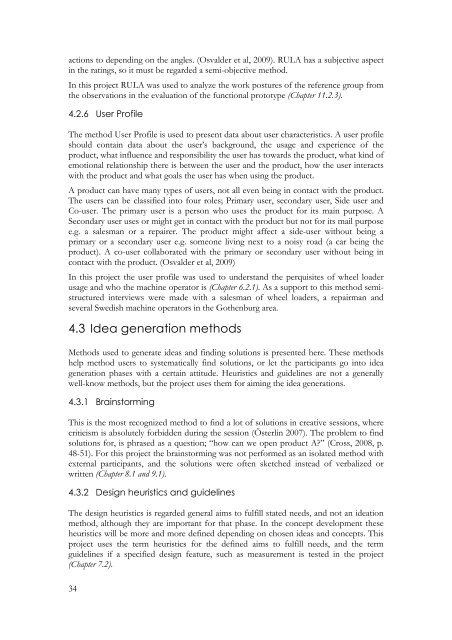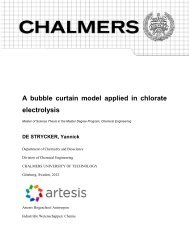Design of an ergonomic control lever for wheel loader attachments
Design of an ergonomic control lever for wheel loader attachments
Design of an ergonomic control lever for wheel loader attachments
Create successful ePaper yourself
Turn your PDF publications into a flip-book with our unique Google optimized e-Paper software.
actions to depending on the <strong>an</strong>gles. (Osvalder et al, 2009). RULA has a subjective aspect<br />
in the ratings, so it must be regarded a semi-objective method.<br />
In this project RULA was used to <strong>an</strong>alyze the work postures <strong>of</strong> the reference group from<br />
the observations in the evaluation <strong>of</strong> the functional prototype (Chapter 11.2.3).<br />
4.2.6 User Pr<strong>of</strong>ile<br />
The method User Pr<strong>of</strong>ile is used to present data about user characteristics. A user pr<strong>of</strong>ile<br />
should contain data about the user’s background, the usage <strong>an</strong>d experience <strong>of</strong> the<br />
product, what influence <strong>an</strong>d responsibility the user has towards the product, what kind <strong>of</strong><br />
emotional relationship there is between the user <strong>an</strong>d the product, how the user interacts<br />
with the product <strong>an</strong>d what goals the user has when using the product.<br />
A product c<strong>an</strong> have m<strong>an</strong>y types <strong>of</strong> users, not all even being in contact with the product.<br />
The users c<strong>an</strong> be classified into four roles; Primary user, secondary user, Side user <strong>an</strong>d<br />
Co-user. The primary user is a person who uses the product <strong>for</strong> its main purpose. A<br />
Secondary user uses or might get in contact with the product but not <strong>for</strong> its mail purpose<br />
e.g. a salesm<strong>an</strong> or a repairer. The product might affect a side-user without being a<br />
primary or a secondary user e.g. someone living next to a noisy road (a car being the<br />
product). A co-user collaborated with the primary or secondary user without being in<br />
contact with the product. (Osvalder et al, 2009)<br />
In this project the user pr<strong>of</strong>ile was used to underst<strong>an</strong>d the perquisites <strong>of</strong> <strong>wheel</strong> <strong>loader</strong><br />
usage <strong>an</strong>d who the machine operator is (Chapter 6.2.1). As a support to this method semistructured<br />
interviews were made with a salesm<strong>an</strong> <strong>of</strong> <strong>wheel</strong> <strong>loader</strong>s, a repairm<strong>an</strong> <strong>an</strong>d<br />
several Swedish machine operators in the Gothenburg area.<br />
4.3 Idea generation methods<br />
Methods used to generate ideas <strong>an</strong>d finding solutions is presented here. These methods<br />
help method users to systematically find solutions, or let the particip<strong>an</strong>ts go into idea<br />
generation phases with a certain attitude. Heuristics <strong>an</strong>d guidelines are not a generally<br />
well-know methods, but the project uses them <strong>for</strong> aiming the idea generations.<br />
4.3.1 Brainstorming<br />
This is the most recognized method to find a lot <strong>of</strong> solutions in creative sessions, where<br />
criticism is absolutely <strong>for</strong>bidden during the session (Österlin 2007). The problem to find<br />
solutions <strong>for</strong>, is phrased as a question; “how c<strong>an</strong> we open product A?” (Cross, 2008, p.<br />
48-51). For this project the brainstorming was not per<strong>for</strong>med as <strong>an</strong> isolated method with<br />
external particip<strong>an</strong>ts, <strong>an</strong>d the solutions were <strong>of</strong>ten sketched instead <strong>of</strong> verbalized or<br />
written (Chapter 8.1 <strong>an</strong>d 9.1).<br />
4.3.2 <strong>Design</strong> heuristics <strong>an</strong>d guidelines<br />
The design heuristics is regarded general aims to fulfill stated needs, <strong>an</strong>d not <strong>an</strong> ideation<br />
method, although they are import<strong>an</strong>t <strong>for</strong> that phase. In the concept development these<br />
heuristics will be more <strong>an</strong>d more defined depending on chosen ideas <strong>an</strong>d concepts. This<br />
project uses the term heuristics <strong>for</strong> the defined aims to fulfill needs, <strong>an</strong>d the term<br />
guidelines if a specified design feature, such as measurement is tested in the project<br />
(Chapter 7.2).<br />
34
















